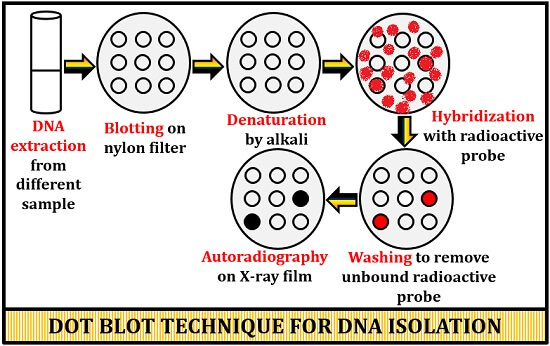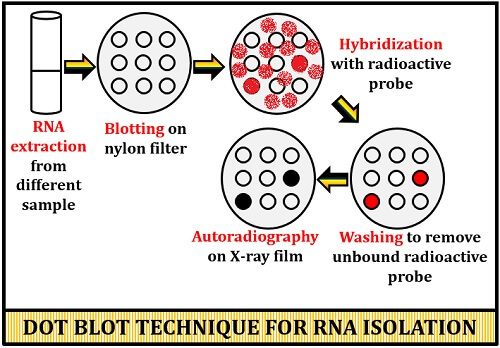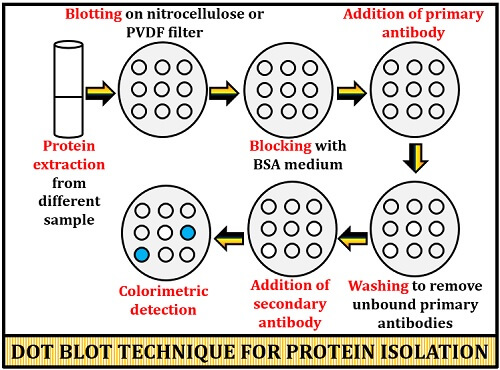Dot blot technique is a method of identifying DNA, RNA and Protein in the sample. It is the simplified form of Southern, Northern and Western blotting for DNA, RNA, and protein isolation, respectively.
This method can detect the presence or absence of biomolecule in a single run. Dot blot technique is a prevalent method in genetic engineering. This technique can detect a specific sequence of DNA and mRNA from the transgenic animals or different tissues.
Content: Dot Blot Technique
Definition
Dot blot technique is also called slot blot technique. It can define as the process of identifying biomolecules like DNA, RNA or protein in different samples taken from different cells or tissues of the individuals. Dot blot method has an advantage over the other blotting methods, as it does not involve running of the sample on the gel matrix.
Types of Dot Blot Techniques
The dot blot technique is different for the isolation of DNA, RNA and protein. Based on the isolation method of biomolecules like DNA, RNA and protein, A dot blot technique is classified into three types:
DNA Isolation
The identification of DNA by dot blot technique involves the following steps:

- Extraction of DNA: Take different samples of the DNA from the different tissues or cells.
- Blotting: It is a second step that involves the blotting of the different DNA sample directly onto the nitrocellulose or nylon filter membrane.
- Denaturation: The ds-DNA is denatured into the single strands through alkali treatment.
- Hybridization: After denaturation, add a radioactive probe to the filter medium containing a DNA sample. A radioactive probe will bind to the target DNA or later hybridize it.
- Washing: After hybridization, wash the unbound or free radioactive probe from the filter medium.
- Autoradiography: Subject the filter membrane to the X-ray film, after which one can visualize the desired gene of DNA.
RNA Isolation
The identification of RNA by dot blot technique involves the following steps:

- Extraction of RNA: Take different samples of the RNA from the different tissues or cells.
- Blotting: It is a second step that involves the blotting of the different RNA sample directly onto the nitrocellulose or nylon filter membrane.
- Hybridization: Add the radioactive probe to the filter medium containing the RNA sample. The radioactive probe will complementarily pair with the target RNA or hybridize the RNA.
- Washing: After hybridization, wash the unbound or unhybridized radioactive probe from the filter medium.
- Autoradiography: Expose the filter membrane to the X-ray film to visualize the target RNA.
Protein Isolation
The identification of Protein by dot blot technique involves the following steps:

- Extraction of Protein: Take out different protein samples from different tissues or cells.
- Blotting: It involves the addition of different protein sample directly onto the nitrocellulose or PVDF filter membrane.
- Blocking: Then, add bovine serum albumin (BSA) medium or dry milk to block the extracellular space in the filter membrane.
- Addition of primary antibody: The primary antibodies fix with the target protein molecule.
- Washing: After binding the primary antibody with the target protein, wash the filter paper to wash off the unbound primary antibodies by using the PBS buffer.
- Addition of secondary antibody: The secondary antibody specifically binds with the primary antibodies. The secondary antibodies attach with the enzymes. Add substrate after the attachment of the secondary antibody with the primary antibody. The addition of substrate will give a specific colour to the sample.
- Colourimetric detection: Measure the intensity of colour by using the colourimeter.
Advantages
- Dot blot technique does not require the separation of bands on the solid support medium (agarose), or there is no requirement of electrophoresis.
- One can detect the presence or absence of genes from the sample of transgenic individuals in a single test run.
- It does not involve immobilization of the biomolecules from a gel matrix to the filter membrane.
- Dot blot technique aids in direct blotting of biomolecule onto the membrane.
Disadvantages
- Dot blot method does not give any qualitative information about the target biomolecules’ size and molecular weight.
- It does not provide a basis for comparing an original and a modified target biomolecule within the same slot.
Applications
- Dot blot technique is widely used to detect protein concentration.
- The specific sequence of a gene can also be detected in a transgenic individual.
Conclusion
Therefore, a dot blot technique is a method of detecting DNA, RNA and protein from the different sample characterized by the different spots. Each spot will represent one sample. The dot blot technique’s main principle is based on the hybridization method, where a specific radioactive probe will bind with the desired DNA, RNA or protein.
This article explains a comparison between methods, which was necessary.